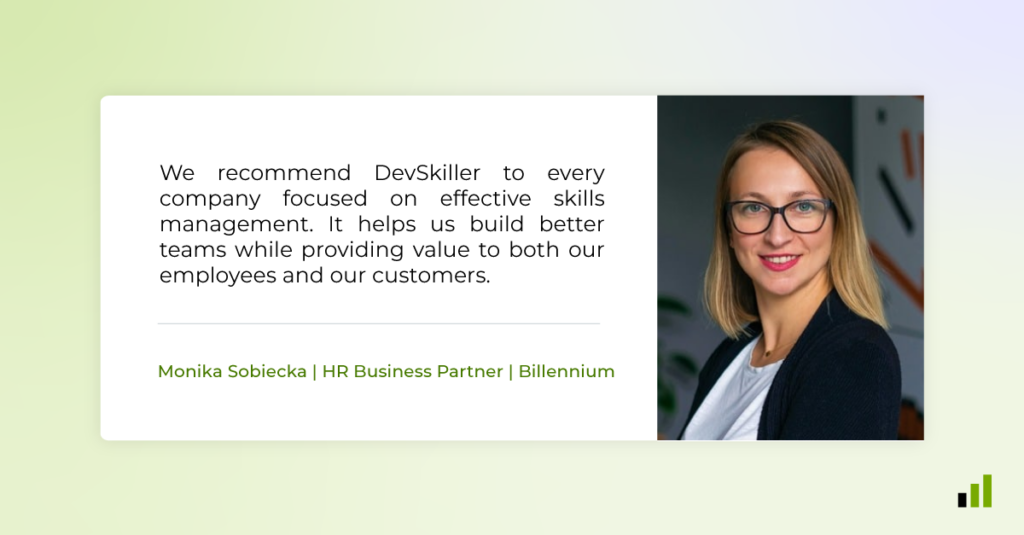The ultimate guide to employee upskilling strategies

In today’s rapidly evolving business landscape, staying ahead of the curve is no longer optional—it’s essential. One of the most impactful ways to achieve this is by investing in employee upskilling.
Welcome to the ultimate guide to employee upskilling strategies, where we delve into the why, what, and how of empowering your workforce for success in the digital age.
What Is Upskilling?
Before diving into strategies, let’s establish a clear upskilling definition. Upskilling is the process of teaching your employees new skills or enhancing their existing ones to improve their performance in their current roles. It’s about providing them with the tools and knowledge they need to excel in the face of changing demands and technological advancements. Unlike reskilling, which focuses on training employees for entirely new roles, upskilling equips them to thrive in their current positions, enhancing their value to the organization.

The Need For Upskilling In the Digital Age
The digital age is characterized by rapid advancements in technology, fundamentally shifting the skills needed to thrive in the modern workplace. To adapt and remain competitive, businesses and employees need to embrace upskilling. Below are a few reasons why upskilling is essential in the digital age.
Rapid Technological Advancements
Technology is constantly evolving, with new tools, platforms, and software emerging frequently. This constant evolution requires employees to continuously update their skills to stay relevant and proficient in using the latest technologies. Upskilling helps them acquire the knowledge and capabilities to leverage these advancements effectively, improving their performance and productivity.
Automation and AI
The rise of automation and artificial intelligence (AI) is transforming industries and reshaping job roles. Many routine tasks are being automated, leading to a demand for professionals with skills in areas like data analysis, AI programming, and machine learning. Upskilling equips employees with the expertise to navigate this changing landscape, enabling them to take on new roles and responsibilities.
Job Market Competitiveness
As technology rapidly changes, the job market becomes increasingly competitive. Candidates with up-to-date skills and knowledge have a significant advantage in securing sought-after positions. Upskilling helps employees stay competitive by enhancing their existing skill sets and acquiring new ones, making them more attractive to potential employers.
Closing the Skill Gap
There’s a widening gap between the skills employers need and the skills available in the workforce. Upskilling programs can play a vital role in bridging this gap. By providing employees with targeted training and development opportunities, businesses can equip their workforce with the skills necessary to meet current and future demands. This, in turn, benefits both the organization and its employees.

Upskilling vs. Reskilling
While often used interchangeably, mejora y reciclaje de las cualificaciones represent distinct approaches to employee development. Understanding the nuances of each is crucial for tailoring your workforce development strategy effectively. Let’s delve into the differences:
- Upskilling: This focuses on enhancing the existing skill sets of your employees. It involves providing training and development opportunities that build upon their current knowledge and expertise within their respective roles. Upskilling empowers employees to perform their current jobs more efficiently and effectively. Imagine a marketing assistant learning advanced SEO techniques to boost their content creation skills — that’s upskilling in action.
- Reskilling: Reskilling involves equipping employees with entirely new skills to prepare them for different roles within the organization. This becomes particularly relevant in industries undergoing rapid transformation, where existing job roles might become obsolete or require a new set of competencies. Think of a data entry clerk transitioning into a data analyst role after acquiring data analysis and interpretation skills — that’s reskilling.

How to Develop an Upskilling Strategy for Your Workforce
Once you understand the importance of upskilling and have conducted a skill gap analysis, you can start developing an effective upskilling strategy for your workforce. Here’s how to develop a successful strategy:
Conduct a Skill Gap Analysis
A crucial first step in deciding between upskilling and reskilling is to identify the gap between your current workforce skills and the skills needed for future success. This involves:
- Evaluating Current Skills: Start by assessing the existing skills and competencies within your workforce. This can involve reviewing resumes, conducting skills assessments, or holding one-on-one discussions with employees.
- Identifying Future Skills: Determine the skills that will be essential for your organization’s growth and competitiveness in the years ahead. Consider industry trends, technological advancements, and the evolving needs of your customer base.
- Analyzing the Gap: Compare the results of your current skills evaluation with your future skills projections. This analysis will reveal any discrepancies or skill gaps that need to be addressed through upskilling or reskilling initiatives.
Build upskilling into your employee development plans
Upskilling should be an integral part of your employee development plans. You can do this by setting clear learning and development goals for your employees. Make sure these goals are aligned with your company’s overall business objectives. This will ensure that employee upskilling initiatives contribute to the company’s success.
Choose your employee training method
There are many different methods for providing upskilling opportunities, and the best choice for your company will depend on your specific needs and goals. Some common employee training methods include:
- Microlearning: This involves delivering bite-sized learning content, perfect for fitting into busy schedules.
- Mentorship: Pairing experienced employees with less experienced ones can facilitate knowledge transfer and skill development.
- Lunch and learns: These informal sessions offer employees a chance to learn from each other and share knowledge.

Utilize technology
Technology can play a vital role in facilitating employee upskilling. Learning Management Systems (LMS), for example, streamline the delivery of online courses and track employee progress. Tools like the DevSkiller TalentBoost platform offer valuable functionalities such as skills gap identification and personalized learning pathways.
Providing learning in the flow of work
The modern workplace is dynamic and demands adaptability. Learning in the flow of work incorporates learning seamlessly into daily tasks. This method ensures that employees can apply newly acquired knowledge immediately, maximizing its impact.
Follow Up and Track Progress
Regularly assessing the effectiveness of your upskilling strategy is crucial. Track employee progress, gather feedback, and make necessary adjustments. Using a data-driven approach helps you optimize your strategy and ensure its continued relevance in the face of evolving business needs.
The Benefits of Upskilling for Employers and Employees
Investing in your workforce through upskilling initiatives is mutually beneficial. It leads to a more engaged, productive, and future-ready workforce. Simultaneously, your company reaps the rewards of increased innovation and profitability.
Upskilling benefits for employees
Upskilling your employees brings numerous advantages for them:
- Career Advancement: By acquiring new skills, employees can unlock new opportunities for career progression within your company. They can take on new roles and responsibilities, leading to greater job satisfaction and earning potential.
- Increased Confidence and Morale: Equipping your team with the latest skills boosts their confidence and sense of value within the company. Feeling more competent and capable empowers them to make more significant contributions to the company. Frequent, personalized recognition increases the odds of employee engagement by 9x and great work by 13x.
- Job Security: Upskilling employees in the face of a rapidly evolving job market is vital for ensuring their long-term employability. By staying ahead of the curve, they become more valuable assets, reducing the risk of job displacement.
- Stay Relevant: In the technology-driven world, acquiring new skills ensures that employees remain relevant and competitive in the job market. Continuous learning is crucial for professionals who want to stay ahead of the curve and future-proof their careers.
- Personal Growth: The process of learning new skills enhances employees’ personal and professional development. This empowers them to be more adaptable and resilient in the face of change.

Upskilling benefits for companies
Upskilling the workforce offers significant advantages for companies, too. Some of the key benefits for companies include:
- Increased Productivity and Efficiency: Upskilling equips your employees with the skills and knowledge to perform their jobs more effectively. This translates into increased productivity and operational efficiency.
- Improved Employee Retention: Investing in your employees’ development demonstrates your commitment to their growth. This fosters a positive work environment, increasing employee loyalty and reducing turnover rates.
- Enhanced Innovation: By fostering a culture of continuous learning, you encourage creativity and innovation within your organization. Upskilling employees empower them to think outside the box and contribute fresh ideas.
- Attract Top Talent: Organizations known for prioritizing employee development attract top talent seeking growth and advancement opportunities. Building a reputation for upskilling gives you a competitive edge in the talent market.
- Close the Skill Gap: Upskilling programs directly address the skills gap by equipping your existing workforce with the skills needed to meet evolving business requirements. This reduces the need for costly external recruitment.

7 Ways to Upskill Your Workforce
Let’s explore various approaches to implement upskilling programs that can effectively upskill your workforce. Here are some upskilling examples you can use:
Microlearning
Microlearning is a great way to deliver bite-sized learning content to your employees. This approach involves short, focused modules that address specific learning objectives. Since these modules are short, employees can easily fit them into their busy schedules. Microlearning can be delivered through various formats such as videos, quizzes, and interactive games.
Mentors & Subject Matter Experts
Mentorship programs are a valuable way to upskill employees by pairing them with experienced professionals within your organization. Mentors can provide guidance, share their expertise, and support the employee’s professional development. Similarly, engaging subject-matter experts for specific training sessions or workshops can offer focused expertise in niche areas.
Outsourcing
Outsourcing training can be an efficient strategy, especially for specialized skills or when in-house expertise is limited. You can leverage external training providers or consultants to deliver specialized programs tailored to your workforce’s needs.
Self-training
Empowering employees to take ownership of their learning is essential for a successful upskilling strategy. You can facilitate self-training by providing access to online learning platforms, industry journals, and relevant books. Encourage employees to explore areas of interest and develop skills at their own pace.
Classroom Training
Traditional classroom training remains an effective method for delivering comprehensive instruction. It allows for instructor-led sessions, interactive discussions, and hands-on activities. This approach is particularly beneficial for complex topics that require in-depth explanation and practical application.
Virtual Classroom Training
Virtual classroom training offers a flexible alternative to traditional classroom settings. Through virtual platforms, employees can participate in live, interactive sessions from remote locations. This approach saves time and resources while still providing engaging instruction.
Lunch and Learns
Lunch and learns provide informal learning opportunities where employees can gather during their lunch breaks to discuss a specific topic. These sessions can be led by internal experts or guest speakers. They offer a relaxed and engaging setting for learning and knowledge sharing.
Última palabra
Investing in employee upskilling is a strategic move for any company. DevSkiller recognizes the importance of closing the skills gap in today’s dynamic workplace. The DevSkiller TalentBoost platform provides targeted upskilling opportunities, allowing companies to cultivate a highly skilled and future-ready workforce.
By understanding and harnessing the power of employee upskilling, your organizations can position themselves for sustained growth and success in the ever-evolving digital landscape.
Preguntas frecuentes
- What drives the need for upskilling in businesses today?
Rapid technological advancements and dynamic business landscapes are primary drivers. - Is there a significant financial implication for upskilling?
While there’s an upfront cost, the long-term benefits in terms of productivity and efficiency offer a substantial ROI. - How do companies identify areas for upskilling?
Through regular skills assessments, feedback, and keeping abreast with industry trends. - Are there sectors where upskilling is more prevalent?
Upskilling is vital across sectors, but it’s especially pronounced in tech, finance, healthcare, and manufacturing.
Compartir post